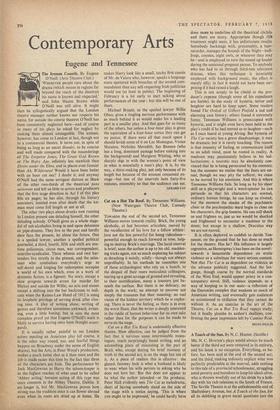Cat on a Hot Tin Roof. By Tennessee Williams. (New
Watergate Theatre Club, Comedy Theatre.) TOWARDS the end of the second act, Tennessee Williams moves towards reality. Brick, the young alcoholic, at last becomes articulate, moved by the recollection of his love for a fellow athlete : love not the less powerful for being ridiculous— powerful enough to reach forward in time, help- ing to destroy Brick's marriage. The lucid interval is brief; soon the author is up to his old, madden- ing tricks again, not so much exploring his subject as thrashing it noisily, wildly—though not always unprofitably. In his methods he resembles one of those archaeologists who rely on a hunch, to the despair of their more meticulous colleagues, tearing up a great acreage of ground and revealing, to their mortification, many a treasure just be- neath the surface. But there is no delicacy, no depth in the work; no attempt to uncover not simply the treasures but their meaning; no real vision of the hidden territory which he is explor- ing. There is never the feeling, as there is in even the worst Ibsen, that the writer is deeply interested in the riddle of human behaviour for its own sake rather than for the purposes it can be made to serve on the stage.
Cat on a Hot Tin Roof is undeniably effective theatre. How effective, can be judged from the fact that it survives some interminable mono- logues, much surprisingly banal writing, and an astonishing piece of miscasting in the part of Brick who, except during his brief moment of truth in the second act, is on the stage but not of it. As a piece of realism this is effective : the glazed, faraway look is what a husband is likely to wear when his wife persists in asking why he does not love her. But this does not appear to be what the author intended—or the producer. Peter Hall evidently sees The Cat as melodrama; short of having somebody stand on the side of the stage with a notice saying, 'This is where you ought to be impressed,' he could hardly have
done more to underline all the theatrical clichés, and there are many. Appropriate though this treatment might seem, it has unfortunate results. Somebody backstage with, presumably, a tape- recorder, manages the Sounds of the Night—bull- frogs, coyotes, night owls, or whatever they may be—and is employed to turn the sound up louder during the sustained pregnant pauses. To anybody who has had to sit through third-rate television dramas, when this technique• is invariably employed with background music, the effect is merely silly; in fact it would not have been sur- prising if it had raised a laugh.
This is not simply to be ribald at the pro- ducer's expense (though some of his expedients are feeble). In the study of hysteria, terror and laughter are hard to keep apart. Some readers found The Ordeal of Gilbert Pinfold a sad and alarming case history; others found it extremely funny. Tennessee Williams is preoccupied with hysteria, and it might even have been held to the play's credit if he had moved us to laughter—such as I once heard at young Alving. But hysteria of The Cat variety has a grave disadvantage; it may be dramatic but it is rarely touching. The reason is that intensity of feeling, to communicate itself to an adult mind, must be rooted in reality. A madman may passionately believe in his hal- lucinations; a neurotic may be absolutely con- vinced that he is being persecuted by his enemies; but the moment we realise that the fears are un- real, though we may pity the sufferer, we cease to be moved by his emotions. And this is where Tennessee Williams fails. So long as by his sheer skill as a playwright and a word-spinner he can persuade us that his characters are normal, ordinary human beings, he can keep us riveted; but the moment 'the shades of the psychiatric clinic or the psychopathic ward begin to close on his characters, the grip loosens. He can still shock us and frighten us, just as we would be shocked and frightened to encounter a madman in the street; but except in a shallow, Draculan way we are not moved.
It is often deplored as caddish to deride Ten- nessee, on the ground that he has done so much for the theatre. Has he? His influence is largely regressive, as Hemingway's has been on the novel : towards a lamentable dependence on erotic violence as a substitute for more serious content. Not that The Cat is as dependent on violence as the advance publicity suggested. And the lan- guage, though coarse by the normal standards of the West End, would appear prissy in a con- temporary novel. Still, violence impends, as a way of keeping us in our seats—a reflection of the Damocles complex that weakens so much of American writing, and eventually gets audiences so accustomed to titillation that they cannot do without it. As an exercise in the art of the Theatre, Cat on a Hot Tin Roof repays study; but it finally plumbs its author's shallows, con- firming the poor impression left by Camino Real.
BRIAN INGLIS


































 Previous page
Previous page